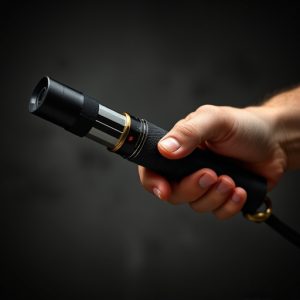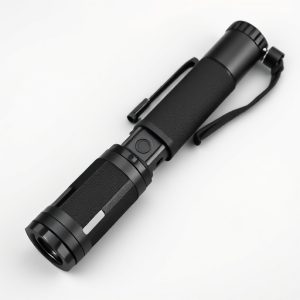Enhancing Officer Safety: The Role and Evolution of Self-Defense Expandable Batons in Modern Law Enforcement
Self-defense expandable batons are indispensable tools for law enforcement, offering a blend of fun…….
Self-defense expandable batons are indispensable tools for law enforcement, offering a blend of functionality and effectiveness that enhances control and reach during encounters. These collapsible batons serve as both restraint and protective measures, providing a strategic advantage by maintaining proximity defense while allowing officers to manage distance in confrontational situations. Their compact design facilitates easy carriage and swift deployment, ensuring agility and readiness for officers on duty. As force multipliers, expandable batons can deliver controlled impact force to incapacitate individuals when necessary, complementing de-escalation techniques. The precision of these batons depends on proper training, which is essential for safe and effective use in high-risk situations. A high-quality expandable baton should be made from durable materials like aircraft-grade aluminum or stainless steel, feature a reliable locking mechanism to prevent accidental deployment, and have an ergonomic design that enhances control and accuracy, minimizing collateral damage. Additional key features include non-reflective finishes for stealth operations, low-noise deployment to maintain surprise, high impact resistance, ease of maintenance, and comprehensive user manuals or training resources. Legality is a top priority, ensuring the baton complies with all relevant laws and regulations governing its use in law enforcement contexts. The evolution of these batons has led to improved designs that are more user-friendly, reliable, and durable, incorporating advanced materials and safety features that prevent accidental opening or closing. Modern models may also include features like LED lights and audio devices to aid officers in their duties. For the safe application of self-defense expandable batons, comprehensive training programs are necessary, covering legal aspects, mechanics, and a variety of maneuvers for effective confrontation management. Regular scenario-based drills help officers maintain sharp reaction times and situational awareness. Clear guidelines informed by industry best practices ensure that both subjects and officers remain safe, and continuous evaluation of field experiences refines policies to keep these tools functioning optimally. Routine maintenance is crucial for maintaining the baton's functionality, making self-defense expandable batons an integral component in law enforcement's efforts to protect life and preserve public order.
Law enforcement officers are tasked with maintaining public safety, a role that often requires them to be prepared for various confrontational scenarios. A critical component of their equipment arsenal is the self-defense expandable baton, a versatile tool designed to aid in protection and control during encounters. This article delves into the essential features of high-quality law enforcement gear, particularly focusing on expandable batons, and how advancements in design and technology have shaped their use in modern policing. We will explore best practices for effective training and deployment, ensuring officers can handle situations with both precision and safety in mind. Join us as we examine the role these batons play in the complex landscape of law enforcement gear.
Understanding the Role of Self-Defense Expandable Batons in Law Enforcement
Self-defense expandable batons are an integral component of a law enforcement officer’s arsenal, serving as both a restraint and protective tool. These collapsible batons are designed to extend upon impact, offering increased leverage and reach for officers during altercations. They provide a balance between proximity defense and distance control, allowing officers to manage confrontational situations more effectively. The expandable nature of these batons means they are easily carried and deployed, ensuring readiness without compromising on the officer’s mobility.
When selected and utilized correctly, self-defense expandable batons can be a force multiplier for law enforcement personnel. They are engineered to deliver controlled impact force, which can incapacitate an assailant when other methods of de-escalation or less lethal options are insufficient. The effectiveness of these batons lies in their ability to subdue threats while minimizing the risk of serious injury to both the officer and the subject. Proper training is essential to maximize the safety and efficacy of using an expandable baton, as it ensures that officers can deploy this tool with precision and restraint when confronted with potentially violent situations.
Key Features to Look for in High-Quality Law Enforcement Gear
When selecting high-quality law enforcement gear, particularly in the realm of self-defense tools, officers must consider several critical features that ensure both their safety and effectiveness during encounters. A key component of this equipment is the expandable baton, a versatile self-defense weapon that combines portability with potency. An ideal expandable baton should be crafted from durable materials like aircraft-grade aluminum or stainless steel to withstand the rigors of field use while remaining lightweight. It must also feature a reliable locking mechanism to prevent accidental deployment and retract safely, even under stress. The length expansion should occur seamlessly with a single action, allowing for quick deployment in critical situations. Additionally, features such as an ergonomic grip enhance the user’s control and accuracy when deployed, which is essential for effective self-defense and minimal collateral damage. Officers should also look for batons with non-reflective finishes to maintain stealth during operations.
Furthermore, high-quality law enforcement gear must be designed with officer and public safety in mind. The expandable baton’s deployment should be silent or emit a minimal sound to avoid alerting suspects or causing unnecessary alarm. Impact resistance is another vital aspect; the baton should be capable of delivering effective force without breaking. Maintenance ease is also a significant factor, as frequent cleaning and inspection are necessary to ensure the baton remains in optimal condition. Training and familiarity with the equipment cannot be overstated; thus, gear that comes with comprehensive user manuals or training resources can significantly benefit both rookie and seasoned officers. In terms of legal compliance, it is imperative that the expandable baton adheres to local, state, and federal regulations regarding the use of such devices in law enforcement. Ensuring that the gear meets these standards safeguards the officer’s professional integrity and operational efficacy.
The Evolution of Expandable Baton Design and Technology in Modern Policing
Over the years, the design and technology behind expandable batons have undergone significant advancements, reflecting the evolving needs of modern law enforcement. These collapsible batons, often integral for self-defense in policing contexts, have transitioned from simple mechanical devices to sophisticated tools with enhanced functionality and safety features. Early models were straightforward and relied on manual force to extend and contract, making them effective but also demanding in terms of skill and technique. The evolution of expandable batons has led to models that are not only easier to operate but also more reliable and durable. Modern iterations incorporate elements such as aluminum or other lightweight, yet strong materials, which have significantly reduced the weight without compromising on structural integrity. Additionally, newer designs feature safety mechanisms that prevent accidental deployment or closure, ensuring the well-being of both officers and suspects. The integration of high-strength materials has also allowed for batons to be designed with multiple segments, increasing their reach and impact potential while still maintaining a compact form factor for ease of carry and storage. In the realm of self-defense expandable batons, the latest technological advancements include models equipped with LED lights or integrated audio devices, providing officers with additional tools to deter threats and ensure public safety. These enhancements underscore the ongoing commitment to refining law enforcement gear to meet the demands of contemporary policing challenges.
Best Practices for Training and Deployment with Self-Defense Expandable Batons in Law Enforcement Settings
Law enforcement officers often encounter situations where they must protect themselves and others, while maintaining public safety. Self-defense expandable batons serve as a critical tool in such scenarios, offering a balance between control and effectiveness. Best practices for training with these batons are essential to ensure their safe and proper use. Comprehensive training programs should include both classroom instruction and hands-on practice. Officers must understand the legal implications of baton use, the mechanics of deployment and retraction, and the techniques for effective maneuvering in a variety of confrontational situations. Regular drills that simulate real-world encounters will enhance an officer’s proficiency with the expandable baton, leading to improved reaction times and situation awareness.
Upon deployment, it is imperative that law enforcement agencies establish clear guidelines for the use of these batons. These guidelines should be informed by best practices that dictate when and how the baton can be used to minimize harm to both subjects and officers. Continuous assessment and feedback from real-world applications will inform policy refinements. Regular maintenance checks are also crucial to ensure the batons remain in optimal condition. By integrating these best practices into training protocols and operational guidelines, law enforcement agencies can effectively utilize self-defense expandable batons as part of their arsenal for protecting life and maintaining public order.


